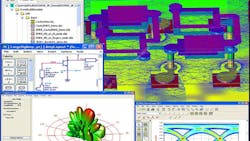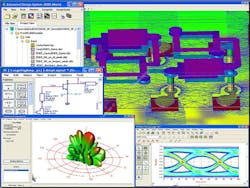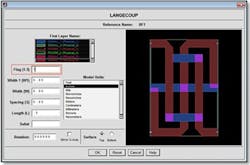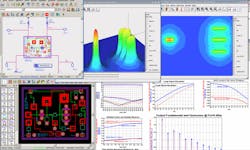Sorting Through Computer Engineering Software
Knowing some of the differences among the myriad simulation software solutions for RF/microwave devices, circuits, and systems makes it much easier to match a high-frequency design software program to a problem or application. Many of these computer-aided-engineering (CAE) tools were on display at the recent 2015 IEEE International Microwave Symposium (IMS) in Phoenix, Ariz., which provided some perspective on the wealth of computer-based design software that applies at RF and microwave frequencies.
This file type includes high resolution graphics and schematics when applicable.
Developers of modern CAE software tools share the common goal of having easy-to-use products, even though many of these software tools contain complex capabilities and vast collections of simulation functions. Challenges in providing a great deal of simulation power include designing a straightforward graphic user interface (GUI) that allows for simple control of the software and ease of access to different routines, capabilities, and models.
In some cases, it’s desirable that different software tools, such as circuit- and system-level simulators, are capable of working with each other. Therefore, GUIs with common features and formats among different software tools can at least make it easier for two different CAE software tools to work together.
It’s safe to say that RF/microwave designers have never had as many options available to them in terms of commercial CAE tools, from device-level simulators and mathematically based calculations to full system-level simulators. Software allows designers to explore possibilities, for example, to investigate the effects of different printed-circuit-board (PCB) materials on amplifier performance or filter design.
Often CAE tools contribute to the specification process, enabling designers to investigate the effects of, say, material parameters like relative dielectric constant tolerance or even thickness tolerance on circuit performance. Prior to CAE software, of course, this meant actually fabricating several circuits on different PCB materials and then testing the results. But with software, simulations have become so accurate that most high-frequency designers trust simulation predictions to be within 1% or better of measured results on a final fabricated circuit.
A Stocked Tool “Chest”
As with business software programs, such as spreadsheets and word processors, CAEs have strengths and weaknesses, and their capabilities vary widely, prompting many designers to maintain a number of different simulation tools. Starting points may be a more or less generic modeling tool like MATLAB from MathWorks, essentially a mathematics-based modeling tool for computers with Windows, Mac, and Linux operating systems (OSs). It’s suitable for developing algorithms and studying circuit and system behavior, such as energy consumption under different temperatures and environmental conditions.
Among high-level system simulators, there’s the Advanced Design System (ADS) software (Fig. 1) from Keysight Technologies. It’s a simple 32- and 64-b program with minimal computer system requirements of 1 GB hard-disk space for just MATLAB and 3 to 4 GB for a typical installation, with at least 2 GB of random access memory (RAM). The program can run on a personal computer (PC) with almost any OS, even older tools such as Windows XP. In contrast, the ADSsimulator—which supports a number of platforms including Windows, Linux, and Solaris—requires a computer with at least 4 GB of RAM; 10 GB of hard-disk storage; a 1.66-GHz, 64-b processor; and even a high-resolution display screen to show results.
The ADS simulator is one of numerous CAE circuit/system simulator programs offered by Keysight (others include GoldenGate, Genesys, EMPro, and SystemVue), in addition to several device modeling programs (e.g., IC-CAP and WaferPro Express). As a large company (and formerly part of Agilent Technologies), Keysight supports the development of, or acquires from other companies, different software tools to provide different approaches to high-frequency modeling and simulation.
To maximize the effectiveness of CAE software, it must be compatible with other software tools. On that front, Keysight recently announced an agreement with CAE developer Intercept Technology to integrate Keysight ADS Board Link macros within Intercept’s Pantheon program (Fig. 2). ADS Board Link is a PCB integration program for bidirectional transfer of layouts, schematics, and model libraries between ADS software and enterprise PCB tools, such as Pantheon. The agreement allows ADS components to be created within Pantheon, essentially forging an integrated software tool from the two programs.
This trend will continue through the vast array of CAE programs currently available to RF/microwave designers, even as CAE software suppliers such as Keysight marches on with advances toits own tools. At IEEE IMS, for example, Keysight demonstrated the capabilities of its ADS Electro-Thermal Simulator for modeling and simulating the effects of temperature and thermal coupling on RF integrated circuits (ICs) and packaged devices. Based on thermal-solver technology, the ADS Electro-Thermal Simulator (Fig. 3) has been applied to a variety of device technologies, including silicon (Si), gallium arsenide (GaAs), and silicon-germanium (SiGe) processes.
One of the older, and still popular, CAE programs is Spice, which provides ac and dc analysis of analog circuits. A number of companies still support some form of Spice-based simulation program, such as Cadence Design Systems and its PSpice software. It offers analog and mixed-signal circuit simulation, simulating circuit performance based on ac, dc, and noise analysis. The firm also furnishes Spectre RF simulation software and its Virtuoso Layout Suite for computer generation of circuit layouts. Additional suppliers of Spice-based simulation tools include Silvaco and its SmartSPICE RF software, and AnaSoft Ltd. with“SuperSpice” software. Also, a number of software suppliers offer tools for analog, digital, and mixed-signal circuit simulation, including DesignSoft with the TINA Pro analog, digital, and mixed-signal circuit simulator; Intusoft and its ICAP/4 mixed-signal simulator; and Helic with its VeloceRF software for modeling RFICs and system-in-package designs.
Another powerful group of software design tools is based on electromagnetic (EM) simulation. Recent enhancements include the ability to perform three-dimensional (3D) modeling and simulation of circuits and structures.
Sonnet Software, one of the leaders in EM simulation tools, has long offered 3D planar EM simulation software based on method-of-moments (MoM) EM analysis. This standalone software has proven to be highly accurate in modeling devices, circuits, and assemblies in terms of high-frequency performance. But the EM simulator is also fully integrated within many other CAE platforms, including ADS, Cadence Virtuoso, the NI AWR Microwave Office design environment from National Instruments and Applied Wave Research, and even MATLAB, enabling an integrated design flow for EM analysis with those tools.
In the case of Ansoft and its Ansoft Designer collection of CAE tools, 3D planar EM simulation software became the basis for a complete suite of circuit-through-system modeling and simulation tools. Similarly, Mentor Graphics evolved its EM simulation capabilities into the System Vision software, which can perform mixed-signal modeling and simulation on devices through systems. Remcom recently reported on itsXFdtd EM simulation software contributing to the design of a high-frequency automotive radar system. And IMST GmbH enhanced its EMPIRE XPU 7.10 3D EM software with an improved graphical user interface (GUI).
Some CAE software tools focus on particular circuit areas or components, such as filters. Examples include ALK Engineering’s filter simulation software and Guided Wave Technology’s filter synthesis and simulation software. Similarly, Mician GmbH offers EM software tools aimed at the design and simulation of waveguide and antennas. Some companies, such as Analog Devices, support the design of specific components (e.g., phase-locked-loop frequency synthesizers) with its ADIsimPLL software (in support of the firm’s ICs, of course).
This file type includes high resolution graphics and schematics when applicable.
Of course, with all of these CAE tools, accurate models are still essential for accurate simulations of any kind. Some companies have built strong reputations within the CAE community for their modeling capabilities, notably Modelithics. It developed a large library of device models for both active and passive devices, and is often recruited by different device suppliers to create accurate models for new devices and components. Recently, the firm contributed heavily to the modeling of the latest gallium-nitride (GaN) semiconductor devices for RF/microwave applications, notably for high-power amplification.
About the Author
Jack Browne
Technical Contributor
Jack Browne, Technical Contributor, has worked in technical publishing for over 30 years. He managed the content and production of three technical journals while at the American Institute of Physics, including Medical Physics and the Journal of Vacuum Science & Technology. He has been a Publisher and Editor for Penton Media, started the firm’s Wireless Symposium & Exhibition trade show in 1993, and currently serves as Technical Contributor for that company's Microwaves & RF magazine. Browne, who holds a BS in Mathematics from City College of New York and BA degrees in English and Philosophy from Fordham University, is a member of the IEEE.




